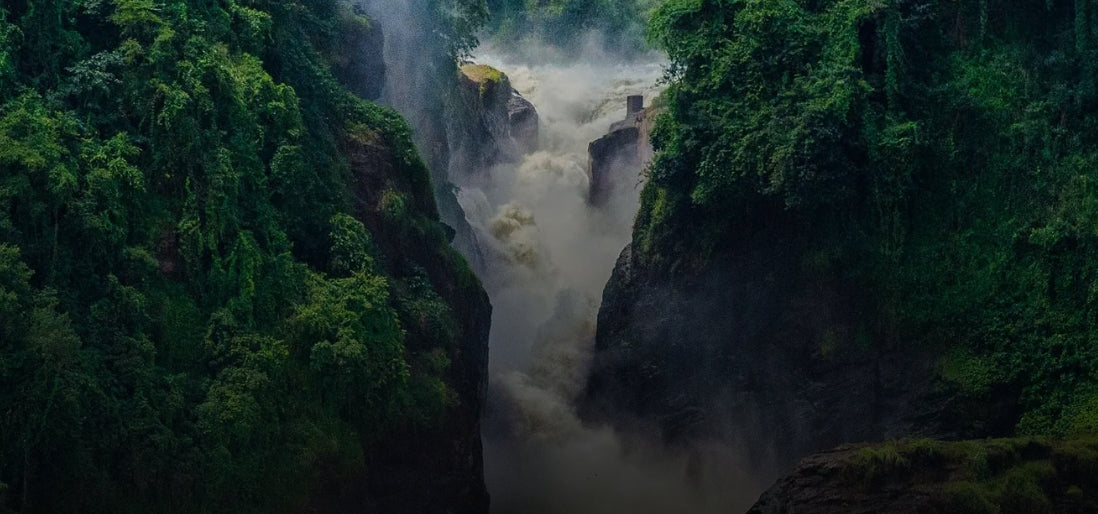
MURCHION FALLS NATIONAL PARK
Share
ABOUT THE PARK
Murchison Falls National Park: Uganda’s Largest and Most Iconic Safari Destination
Murchison Falls National Park is Uganda’s oldest and largest conservation area, covering vast expanses of savanna, woodland, and riverine forests. Originally gazetted as a game reserve in 1926, the park was officially designated as one of Uganda’s first national parks in 1952. It lies at the northern end of the Albertine Rift Valley, where the Bunyoro escarpment descends into rolling, palm-dotted plains, offering one of the most dramatic landscapes in East Africa.
Location : Masindi
Size: 3,840km2
Altitude: 127 m
The Iconic Murchison Falls
At the heart of the park is Murchison Falls, one of Africa’s most powerful waterfalls. Here, the mighty Victoria Nile is forced through a narrow 8-meter-wide gorge, before plunging 45 meters into the Devil’s Cauldron below, sending up a thunderous roar and a permanent rainbow mist. This breathtaking natural wonder marks the final act in an 80km stretch of rapids, after which the river calms into a broad, tranquil flow as it meanders toward Lake Albert.
This stretch of river is one of Uganda’s greatest wildlife viewing spots, attracting elephants, giraffes, and buffaloes to the riverbanks, while hippos, Nile crocodiles, and aquatic birds are ever-present residents.
Diverse Ecosystems and Rich Wildlife
Murchison Falls National Park is home to a remarkable 144 mammal species, 556 bird species, 51 reptiles, and 51 amphibians. The northern section of the park is characterized by open savanna, Borassus palms, and acacia woodland, while the southern section is dominated by woodland and forest patches, offering diverse habitats for a wide range of wildlife.
Key Wildlife Highlights:
- African Elephants – An aerial survey counted over 900 individuals, with numbers steadily increasing.
- Giraffes – Historically, these majestic animals have been exclusive to the northern sector, and their population continues to thrive.
- Buffaloes – Their numbers have soared to over 10,000, making them one of the most commonly seen animals in the park.
- Uganda Kobs – The population has grown to an impressive 35,000 individuals.
- Nile Crocodiles & Hippos – Common along the riverbanks, especially near the Albert Delta.
A Birdwatcher’s Paradise
With over 556 recorded bird species, Murchison Falls is a must-visit destination for bird enthusiasts. The shoebill stork, one of Africa’s most sought-after birds, is commonly spotted along the Albert Delta. Other notable birds include:
-
White-crested turaco – Found in the park’s woodland areas.
-
Red-winged grey warbler – Typically seen in the southern sector.
- African fish eagle, Goliath heron, and the saddle-billed stork.
A Park of Historical Fame
Murchison Falls has attracted some of the world’s most notable explorers, leaders, and adventurers, including:
-
Winston Churchill – Uganda’s most famous early visitor.
-
Theodore Roosevelt – The American president and passionate conservationist.
-
Ernest Hemingway – Who famously survived two plane crashes while visiting the park.
- British Royalty – Several members of the British monarchy have visited the park over the years.
Hollywood and Murchison Falls
In 1951, the legendary Hollywood film “The African Queen” starring Humphrey Bogart and Katharine Hepburn was filmed on Lake Albert and the Nile in Murchison Falls National Park. The film’s setting highlighted the untamed beauty of the region, bringing global attention to Uganda’s wilderness.
Why Visit Murchison Falls National Park?
-
Witness one of the most powerful waterfalls in the world.
-
Explore Uganda’s largest and most diverse national park.
-
Experience incredible wildlife, from elephants and giraffes to crocodiles and hippos.
-
Enjoy a world-class birdwatching experience, including the rare shoebill.
-
Walk in the footsteps of legendary explorers and world leaders.
- Cruise along the Nile and witness wildlife up close.
Murchison Falls National Park is a place of raw beauty, untamed wildlife, and historic significance. Whether you’re looking for thrilling game drives, unforgettable boat cruises, or stunning landscapes, this park offers a truly immersive African safari experience.
PLAN YOUR TRIP
Accessing the park is convenient, with options for both road and air travel. Murchison is located in North-Western Uganda, bordering the districts of Buliisa, Nwoya, Kiryandongo, Masindi and Packwach. From Uganda's capital, Kampala, it's a scenic drive of approximately 305 kilometers, taking roughly 5 to 7 hours. Alternatively, scheduled or chartered flights are available from Entebbe International Airport to Pakuba Airfield, providing a convenient and time-saving option for travelers. The park has several access gates for people traveling from different places, whether one is coming from Kampala, Masindi, Fort portal, Gulu or Kidepo Valley National Park. These include: the Chobe gate, Kichumbanyobo gate, Wankar gate, Bugungu gate, Mubako gate and Tangi gate. Those interested in viewing Lake Albert usually use the Bugungu gate.
It is important to note that the park has two regions; the south and the north. These regions are formed by the River Nile that divides the park into two. The northern part, which is accessible through the Tangi gate is largely punctuated by woodland and savannah while the southern region which is accessible through the Bugungu gate is generally forested. Given this difference in ecosystem and habitat composition, the game drives are done in the northern sector where the
ecosystem favors a plethora of wildlife species, especially mammals. Therefore, visitors who get accommodation in the south tend to cross the Victoria Nile with a ferry to the north for game viewing.
BEST TIME TO VISIT
Murchison Falls National Park can be visited anytime of year from January to December. However, the best time is during the dry season which starts in the month of December and ends in February as well as in June to September. The park is generally hot, representative of the tropical climate with two rainy seasons.
What to bring
- Walking Boots
- Sunscreen
- Insect repellent
- Binocular
- Heavy and light clothes
